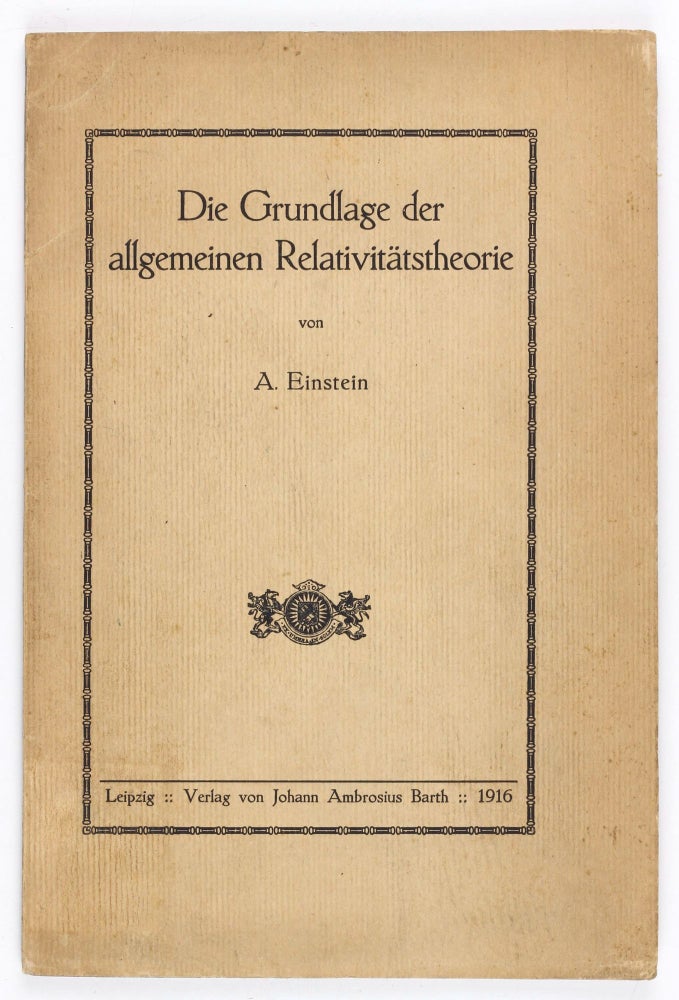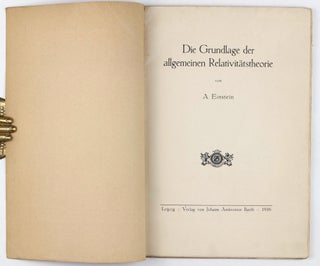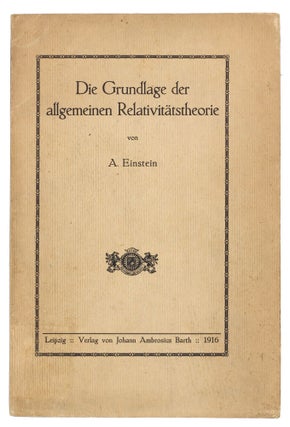Die Grundlage der allgemeinen Relativitätstheorie.
Leipzig: Johann Ambrosius Barth, 1916.
1st Edition. Soft cover. Near Fine. Item #003368
Offprint from: Annalen der Physik, vol. 49. 8vo (245 x 163 mm). [1-2] 3-64 pp. Publisher's original printed wrappers (a triffle dust-soiling and spotting, upper left corner slightly bumped, light discoloration from former sticker wrapped around foot of spine). Text very little age-toned, but in all a crisp, clean and unmarked copy. ----
Grolier/Horblit 26c; PMM 408; Weil *80a. Norman 696 - FIRST EDITION, FIRST PRINTING of Einstein's fundamental statement of the General Theory of Relativity. "Whereas Special Relativity had brought under one set of laws the electromagnetic world of Maxwell and Newtonian mechanics as far as they applied to bodies in uniform relative motion, the General Theory did the same thing for bodies with the accelerated relative motion epitomized in the acceleration of gravity. But first it had been necessary for Einstein to develop the true nature of gravity from his principle of equivalence. Basically, he proposed that gravity was a function of matter itself and that its effects were transmitted between contiguous portions of space-time. Thus the universe which Newton had seen, and for which he had constructed his apparently impeccable mechanical laws, was not the real universe. Einstein's paper gave not only a corrected picture of the universe but also a fresh set of mathematical laws by which its details could be described. [The Haskell Norman Library of Science and Medicine. Part III. R.WE. Clark, Einstein, New York, 1984. "The theory of relativity has transformed astrophysics, and indeed the whole scientific outlook" (PMM 408). "What is today known as the general theory of relativity bears upon the notion of gravity and corrects certain problems in Newtonian physics. It was developed from 1907 until its publication in 1916. The general theory is effectively an extension of the special theory to systems in accelerated motions, such as bodies in space. From the general theory of relativity issues all of 20th-century cosmology - from an explanation of the 'red shift' that indicates the universe is expanding, to the notion of black holes... The great consequence [of the theory] is that gravitation is not simply the force in nature by which all objects are attracted to each other. It is rather the 'warping' of space and time by physical mass. The existence of mass shows that space must be 'curved'-non-Euclidian in shape and measurable, given the speed of light. Although general relativity and classical laws give basically the same results in the ordinary world, Einstein's theory not only can describe the elliptical orbits of the planets, but corrects certain Newtonian anomalies, such as the orbit of Mercury around the sun. Einstein became, virtually overnight, a great public celebrity. On November 7, 1919, the London Times announced: 'Revolution in Science. New Theory of the Universe. Newtonian Ideas Overthrown'" (Simmons, Scientific 100, 11-13). "There were several reprints and facsimiles. The first edition may be identified by the presence of the printer's imprint 'Druck von Metzger & Wittig in Leipzig' on the verso of the title and the shorter imprint 'Metzger & Wittig, Leipzig' on the back wrapper" (Norman). - Visit our website to see more images!
Sold
Delivery time up to 10 days. For calculation of the latest delivery date, follow the link: Delivery times
Lieferzeit max. 10 Tage. Zur Berechnung des spätesten Liefertermins siehe hier: Lieferzeiten






